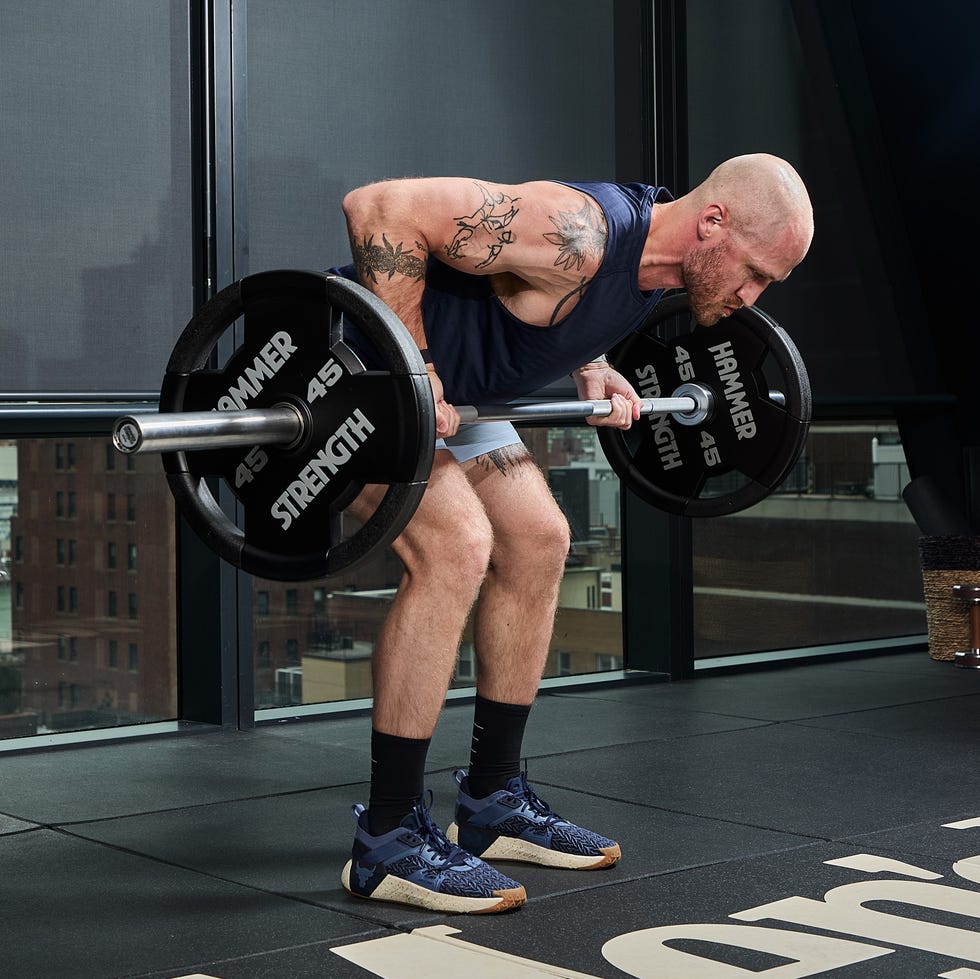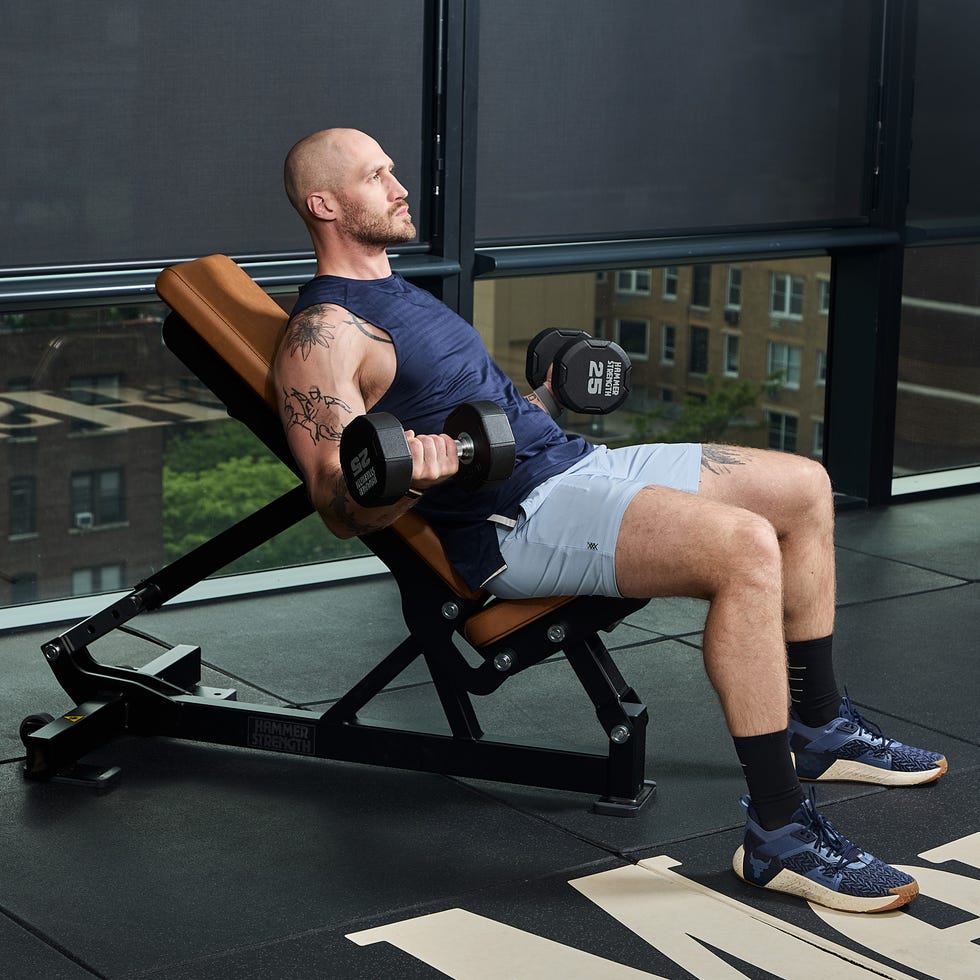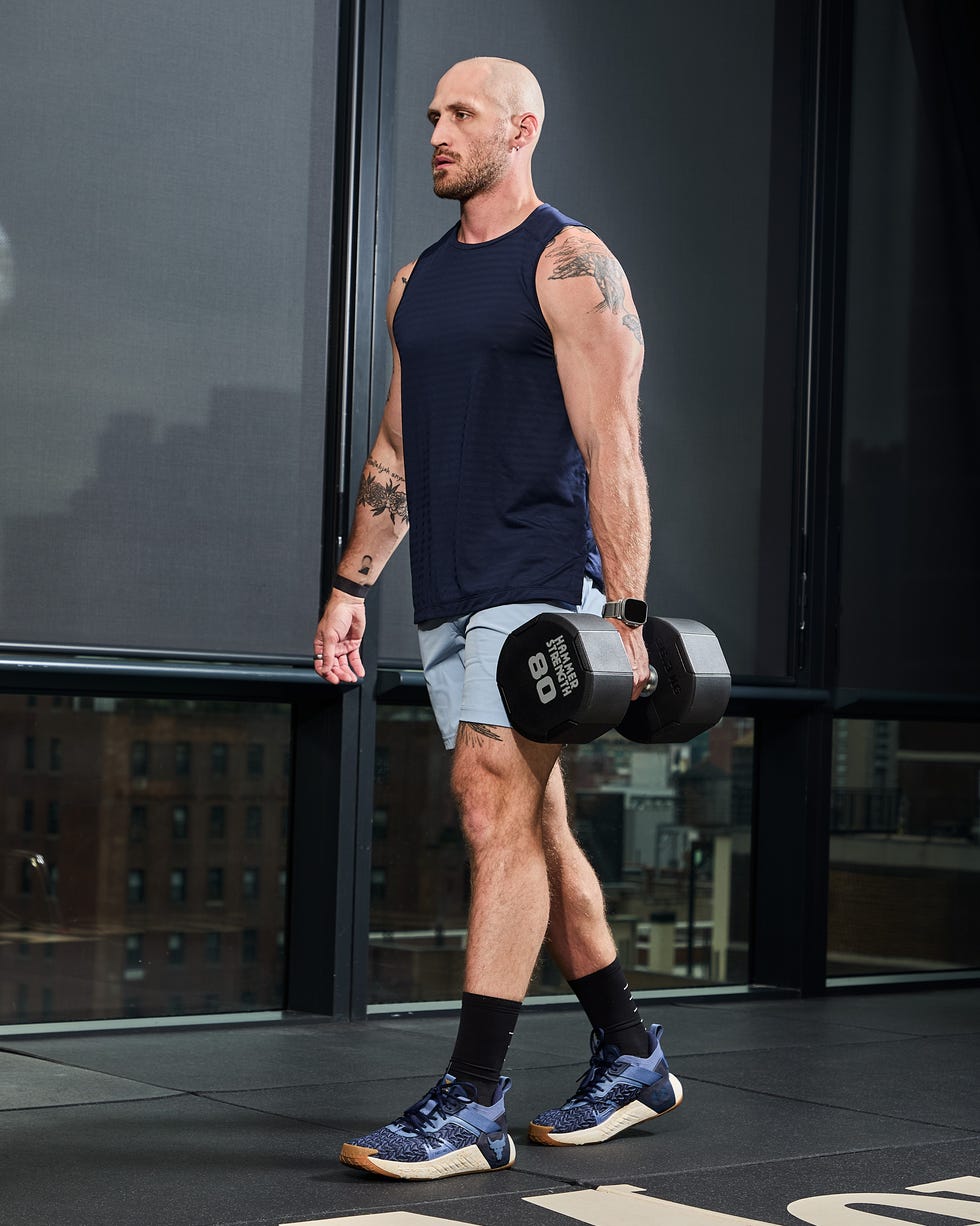THE BIGGEST MOVIE of the summer, Deadpool & Wolverine, depends on consistency even as it introduces a chaotic new element into a well-established universe. Star Ryan Reynolds’ physical preparation reflected that dynamic –which is only appropriate, since Deadpool, the perpetually smirking, fourth-wall busting comic book antihero poised to finally enter the Marvel Cinematic Universe, revels in layers of metatextual humour. Reynolds, now 47, trained for his third appearance as Deadpool/Wade Wilson with Don Saladino, the New York-based strength coach (and MH US Fitness Advisory Board member) he’s worked with for 15 years. But this time around, the pair encountered hurdles they’d never faced before during the process, which led to an experience that challenged Reynolds to evolve into a stronger hero than ever before.
Last year’s writers and actors strikes delayed the filming of Deadpool & Wolverine, which in turn extended the time that Reynolds needed to be ready for the physically demanding role. To hear Saladino tell it, the process was simple – but not easy. “It was a very stressful time for everyone, but I think it was one of those things where suddenly you just were thrown into this pit and you just had to deal with it,” Saladino says. “You just kind of had to fight for yourself, so no one was complaining.” The trainer is quick to note that as the star and producer of the film, Reynolds was also concerned about how the delays would affect the crew members, which compounded that stress.
Add to the complications with the shooting schedule that this was Reynolds’s third outing as Deadpool since 2016 and his first in the MCU. The highly-controlled, arguably declining entertainment juggernaut was the squeaky clean world of squares the Deadpool series initially skewered with its graphic R-rated violence and dirty humour. But the franchise is now kicking off a fresh chapter with the character – so the stakes grew even higher. Saladino had a plan, though, even if the pair was forced to train on Zoom rather than in person. It centred on building on what they had done in the past. “Every movie, we implemented new things, and we had a little bit of a different mindset,” he says. “What really became interesting with this project is that that word ‘resiliency’ was something I feel like he embraced a lot more. He’s now 47 and he’s definitely thinking a little bit differently than he was when I met him, when he was 32 or 33.”
I’ve trained with Saladino before (including in the run-up to Deadpool 2), so I had an idea about what I could expect when I traveled out to The Barn, the gym he runs out of his house on Long Island. The plan was to take on one of the back day workouts the trainer designed for Reynolds in his Deadpool program, and we mostly stuck to that script. But Saladino made sure that we addressed my own needs, too – I was stiff from running more than I’m used to, as I was training for a race – so we focused intentionally on warming up and priming my muscles for movement with foam rolling and activation exercises.
That’s how he trains Reynolds, too: smart choices are emphasized over mindless effort. “Even looking back on what we did for the first Deadpool – or before that, because I’ve been training him all this time – I’m really proud of the approach that we took,” the trainer says. “Did things evolve? Yes. Was it ever that far off? The answer is no.” Saladino has Reynolds focus on his warmups and emphasises tempo and interval work on a motorless treadmill, sled drags, banded falling starts, med ball throwing, and jumping, which are all important for muscle elasticity (the ability of your muscles to return to their original length after being stretched, which is important for healthy movement). The trainer also says that unlike previous projects, he pushed Reynolds to do high-rep sets to prime his muscular endurance before taking on heavy loads.
When Saladino and Reynolds were able to train together in person (in London, where the film was shooting), they squeezed sessions into Reynolds’ packed-out schedule, often working out at 4:30 in the morning. Because Reynolds also produced the film, he had no slow days on set, even when he was sick. “That’s what really becomes challenging working with these actors: it’s not like everyone thinks, [that] it’s all cushy,” Saladino says. “If he wakes up with a terrible sore throat, he’s puking, or whatever – it’s not like, ‘Oh, I can’t come in today.’ What are you fucking kidding me? There’s a hundred people down on set right now.”
Saladino is most proud, then, that he and Reynolds have developed enough rapport over their decade-and-a-half working together that the star is comfortable taking a day off. “This is a guy that ‘going easy’ doesn’t exist in his vocabulary,” Saladino says. “So when someone like that is thinking about taking a day off and recovering, I’m patting myself on my back, because we’ve taught him to understand that [recovery is] really important.”
Reynolds is even better served in the long run with this approach, too. Rather than being burned out at the end of a project, Reynolds is more ready to roll into whatever he has lined up next, says Saladino. The trainer already had ideas in mind for how Reynolds’ next round of workouts might look like, too: more performance-based training, with unilateral work, throws, and whatever else he can cook up. Given all the time they’ve spent together, the trainer knows enough to take the next steps, regardless of the chaos.
I haven’t put in the same amount of time training with Saladino that Reynolds has, but the combination of the strong programming and focused attention elevated the experience beyond how I typically feel in my solo workout sessions. I was able to gut through tough reps of rows, but still felt strong by the time I wrapped up my final set of curls.
Want to try some of the moves from the Deadpool workout? Check out highlights from our back day session below. All of Saladino’s programs (including those Reynolds used for Deadpool and Deadpool 2) are all available here.
THE DEADPOOL BODY MOVES

Barbell Row
Saladino calls this “one of my favourite rowing exercises.” You’ll build back strength while also honing stability, thanks to the bent-over stance.
How to do it:
- Approach the bar as you would for a deadlift. Push your butt back and hinge at the hips to bend over and grasp the bar with your hands just wider than shoulder-width apart, using an underhand grip.
- Keep your head in a neutral position and squeeze your shoulders, abs, and glutes to create tension. Stand up to raise the weight off the floor, then push your butt back and hinge at the hips.
- Move at the elbow and shoulder to row the bar up. “Pull to [your] bellybutton,” says Saladino.
- Control the weight back down to the starting position, maintaining your posture.
SETS AND REPS: 4 sets of 60 seconds

Incline Dumbbell Curl
You’ll work your biceps without the ability to cheat, thanks to your position on the incline bench.
How to Do It:
- Set your incline bench to a 60 degree angle. Lay back on the bench holding a pair of dumbbells, keeping points of contact with your shoulders, lower back, and butt. Allow your arms to hang behind your torso, with your palms supinated (facing away from yourself).
- Squeeze your biceps to curl the weight up, keeping your shoulders out of the motion. “This is a single-jointed movement,” Saladino says, emphasizing the elbow joint for isolation on the biceps.
- Lower the weight back down to the start, holding your position on the bench.
SETS AND REPS: 3 sets of 10 reps

Single-Arm Suitcase Carry
Saladino loves to include loaded carry variations in his workout programs, and for good reason: these simple moves hit multiple muscle groups in one go (in this case the core, upper back, and forearms) and get you moving.
How to Do It:
- Hold a dumbbell in one hand at your side. Squeeze your shoulder blades, abs, and glutes to create full-body tension, keeping your pelvis beneath you in a neutral position. Keep your gaze in front of you and slightly down to keep your neck in a neutral position.
- Walk forward, maintaining that full-body tension and squeezing the bell hard in your hand. “Avoid any leaning,” says Saladino. Keep your core engaged to prevent the weight from pitching you to the side. If you need, you can extend your off arm out for balance.
- After walking the prescribed distance or time, switch hands.
SETS AND REPS: 30 steps
This article originally appeared on Men’s Health US.















